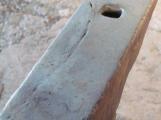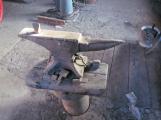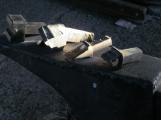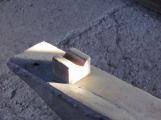2
As important as the forgw was the blacksmiths anvil. As well as being a solid platform on which to work, its mass made the force delivered by the hammer "rebound" and lessen the effort needed to work a piece. An anvil consists of the body,the face and the horn.In the majority of anvils, the body was of cast iron with the face being an inset piece of steel.Steel is stronger than iron so withstands more use.The tapered part of the anvil, used for fine work or cylindrical pieces is called the horn. Behind (left side in this picture) the face of the anvil is a square hole called a Hardy hole. It was used to hold a variety of different tools.4
Here is a selection of Fullering tools5
This tool is to evenly spread a piece of metal that has been split20th century
Main Street, Mossbank SK
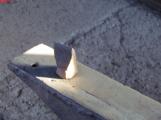
6
This tool would evenly spread a piece of metal which had been split then heated.8
The tool shown here would impart a round profile to the piece being worked.9
Heel of anvil showing Hardy hole and a split repaired by Mr. Ambroz20th century
Main Street, Mossbank SK
